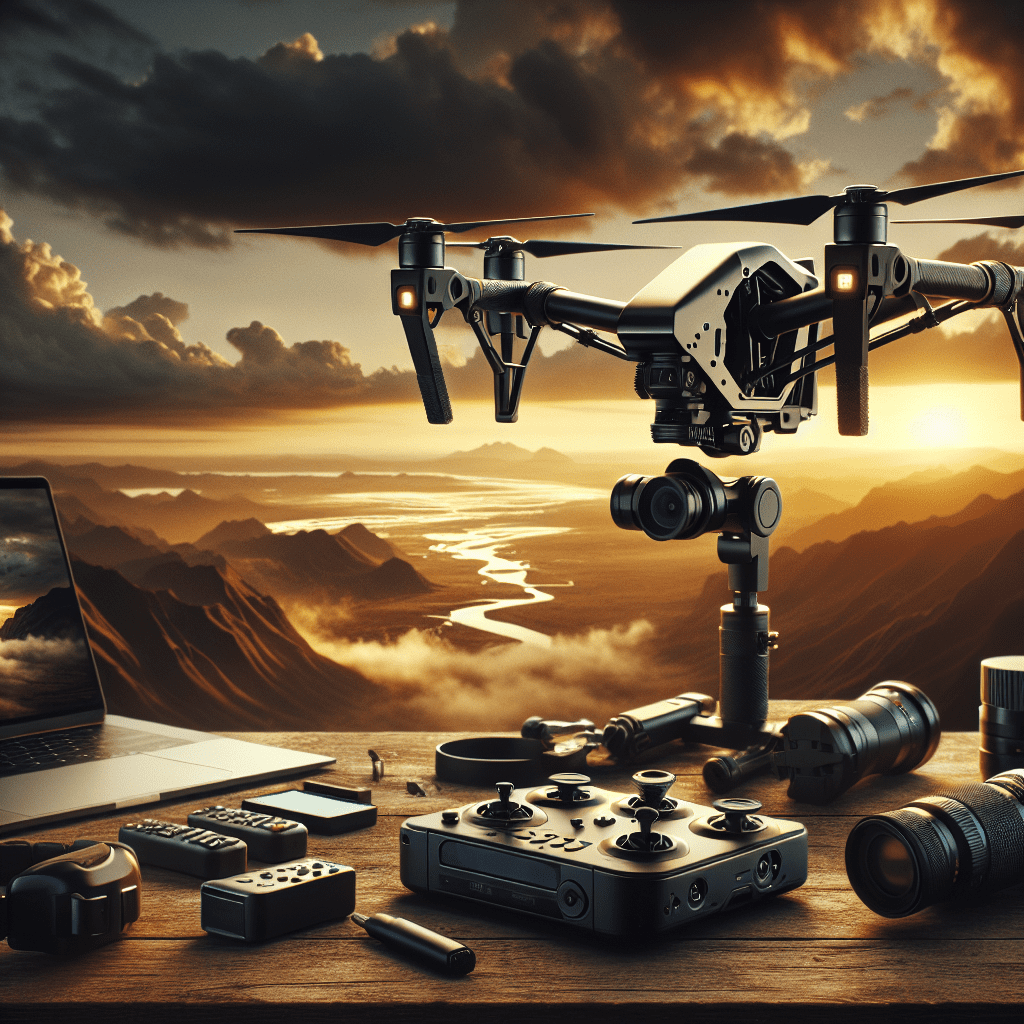Drone ROI & Affordability: Cinematic Footage on a Budget
In This Article
- Drone ROI & Affordability is achievable with the right combination of planning and hardware.
- Under-£100 drones can deliver cinematic visuals with proper technique and timing.
- Avoid common pitfalls by understanding legal, technical, and creative limitations.
- Enhance performance with budget-friendly accessories and community collaboration.
- Prioritise smart purchases based on studio needs, scene requirements, and upgrade paths.
Why Drone ROI Matters for Filmmakers
Understanding Return on Investment in Aerial Filmmaking
The concept of “Drone ROI & Affordability” is more than just getting a good deal on equipment. It’s about leveraging drone technology to generate visual assets that enhance storytelling, boost production value, and ultimately increase viewership and returns. Independent filmmakers and small studios operate in a competitive landscape, where resource constraints dictate the need for strategic financial decisions.
Drone ROI refers to the measurable benefits lenders or owners gain from deploying drones on a film set. It includes time saved on location scouting, increased shot diversity, and enhanced scene immersion—without the costly overhead of helicopters or multi-crew setups. From documentaries to indie features, drones can elevate simple narratives into epic visuals with minimal equipment and crew, provided the investment is initialised wisely.
Affordability, meanwhile, is not just about price tags. It’s also about assessing ongoing costs like replacement parts, firmware upgrades, training, licensing, and insurance. Learning how to strike that balance is vital. For filmmakers with minimal budgets, capturing stable, high-resolution footage with drones under £100 has become increasingly viable. But without insight into performance metrics, this affordability can lead to unanticipated pitfalls—ultimately hurting production flow and return-on-investment ratios.

Top Budget Drones with Cinematic Output
Side-by-Side Drone Comparisons Under £100
Filmmakers often dismiss drones under £100 as mere toys. However, advances in processing chips, image stabilisation, and lightweight materials have made it possible for budget drones to deliver outputs suitable for indie-grade cinematic use. Below is a structured comparison of top-performing drones in this affordability tier, assessed for their viability in real-world filmmaking scenarios.
1. Holy Stone HS110D (£95): This quadcopter comes equipped with 1080p HD video capability and 120° wide-angle lens. It offers features like altitude hold and voice control, making it exceptionally manageable for new drone operators. The absence of a gimbal does impact footage stability, but cinematic shots are still achievable with careful planning.
2. Potensic A20W Mini Drone (£69): Surprisingly capable in low wind conditions, this compact drone supports WiFi-first person view (FPV) and can record directly to a smartphone. Although the video quality peaks at 720p, its stability and manoeuvrability make it a feasible option for scouting and supplementary cutaway footage.
3. Syma X5C-1 (£55): Touted for its resilience and ease of use, the Syma X5C-1 includes a 2MP HD camera and stabilised flight controls. While unsuitable for principal photography, it’s a budget-friendly training drone perfect for learning aerial shot-framing techniques before upgrading to higher-spec models.
“You don’t need to spend thousands; the right £90 drone can do cinematic wonders when placed in skilled hands.”
Balancing Performance with Affordability
While budget drones offer remarkable features, selecting a model purely on cost can hinder your production. A drone’s performance must be assessed against essential filmmaking criteria: camera stability, flight duration, responsiveness, and footage resolution. Affordability becomes irrelevant if a drone fails in windy outdoor conditions or suffers from short battery life, leading to repeated takes and lost daylight hours.
For example, a drone might advertise 1080p video, but without a gimbal or electronic image stabilisation, the final footage may be jittery—undermining production quality. Smart buying decisions therefore require knowledge of what can be adjusted in post-production versus what cannot. Look for drones that offer modular upgrades, like optional gimbals or enhanced propeller guards. These features enhance longevity and performance without the need for large upfront investments.
Features That Impact Cinematic Quality
When it comes to aerial cinematography, some features significantly impact the final visual output. Sensor size, stabilisation technology, lens angle, and control precision make the difference between amateur footage and professional-grade shots. Budget drones are often limited in these respects, but understanding these limitations allows for workarounds through planning and creative direction.
For instance, automatic altitude hold can allow for easier tracking shots, while GPS-enabled drones enable much smoother orbiting shots around subjects. Even lighting differences during golden hour can minimise the loss in detail from smaller image sensors. Matching drone capabilities with your storyboarding process ensures that affordability doesn’t compromise narrative potency.
Stories from Studio-Scale Productions
Small studios across the UK have creatively embraced drones to enrich their narratives. One studio in Manchester used a £90 Holy Stone drone to capture high-angle intros of architectural mini-documentaries. With tight timelines and less than a three-member crew, the drone enabled agile scene transitions and dynamic movement without requiring cinema cranes or dollies.
Another notable example comes from a Leeds-based indie production that used dual-budget drones to film night sequences. Despite lacking native night-vision modes, clever ISO adjustments and location lighting rendered scenes usable. These use-cases highlight that Drone ROI & Affordability isn’t about getting the “perfect” drone — it’s about using the right drone well.
How to Plan Aerial Shots for Maximum ROI
To unlock the fullest ROI from your drone investment, effective planning is essential. Aerial shot lists should be pre-scouted via GPS mapping tools, with contingency plans for weather and wind. Angle considerations, elevation limits, and shot duration should be pre-logged before going airborne.
Use mockups or software visualisers to simulate trajectory paths. Consider dividing your drone shots into: establishing scenes, transitional movement shots, and thematic bird’s-eye cuts. Plan battery usage accordingly so that the most critical shots are secured first. This approach ensures fewer re-shoots and improved post-production turnaround — directly contributing to higher ROI.
Accessories That Boost Drone Performance
Strategic accessories tailored for specific filming requirements can stretch the capability of even the most basic drones. ND filters, for example, moderate exposure under direct sunlight, avoiding footage washout. External storage receivers ensure higher-fidelity video capture if your drone supports OTG connections.
Other low-cost but high-impact accessories include landing pads (to protect sensors from dust), propeller stabilisers (to reduce rotational blur), and LED light kits (for enhanced twilight shooting). Even higher-end smartphone mounts can enable mobile directors to guide the drone visually while using high-quality preview feeds.
Common Mistakes to Avoid in Drone Filmmaking
Many new filmmakers make the mistake of capturing drone footage for its own sake, rather than to serve the narrative. Overshooting aerial footage leads to bloated post-production timelines and less cohesion in the final edit. Additionally, failing to test battery integrity or firmware compatibility before a major shoot can spell disaster.
Another frequent misstep involves ignoring wind ratings. Budget drones are more susceptible to drift or crash under mild gusts. Always check manufacturer guidelines and perform a dry run in similar conditions prior to the principal shoot. Lastly, neglecting to calibrate the drone compass or overlooking geo-fencing limitations could lead to erratic flight paths — a costly mistake during timed production slots.
Drone Laws & Considerations for Indie Filmmakers
In the UK, drone laws are evolving, particularly concerning commercial use. The Civil Aviation Authority (CAA) mandates registration for drones over 250g and requires operators to take a basic competence test. For aerial shots within urban/populated areas, additional permissions are necessary, even if the drone is lightweight.
Indie filmmakers must protect themselves legally by securing flight logs, insurance, and location permits. Failure to do so can halt production and lead to costly fines. Platforms like Top 10 drones for professional filmmaking compared offer comprehensive guides and registration portals that streamline this process. Always account for local airspace restrictions and include this research early during pre-production planning.
Final Tips on Getting Cinematic Shots with a Lean Budget
1. Rehearse with simulator apps before flying—most budget drones offer virtual controllers.
2. Always shoot during natural golden hours to maximise light distribution and minimise harsh shadows.
3. Match drone shots with stable footage from ground cameras to create a seamless viewing aesthetic.
4. Split your aerial footage into thematic sequences so they integrate organically during editing.
5. Collaborate with local drone hobbyist communities to borrow or co-share drones for complex scenes.
If your budget is under pressure, it is still entirely possible to produce professional content using knowledge and preparation. The synergy between planning and gear choice makes the cinematic look attainable, even without high-end equipment.
Buy Smart: Recap of Best-Value Drones and Where to Get Them
To maximise Drone ROI & Affordability, it’s vital to purchase from reputable sources, preferably with post-sale support. Online platforms, especially those outlined in Learn more about Drone Cinematography & Video Production and Read a related article, offer user reviews, accessory bundles, and upgrade options that streamline your buying decision.
A recap of top budget recommendations:
- Holy Stone HS110D: Ideal for beginners seeking pro-style features under £100.
- Potensic A20W: Budget drone with strong signal stability and WiFi FPV.
- Syma X5C-1: Excellent trainer drone with durable build quality.
Use these as entry points into drone cinematography. Later, you can upgrade to modular drone bodies compatible with 4K cameras, once your production budget expands.
Conclusion: Turn Limited Resources into Cinematic Gold
[CONCLUSION_CONTENT]
The future of indie filmmaking is aerial. Strategic integration of drones allows filmmakers to add polish, depth, and modernity to stories—without depleting their financial reserves. By focusing on Drone ROI & Affordability, studios and solo creators alike can transcend limitations and unlock new creative potential from the sky. The right skills, paired with the right tools, convert budget constraints into innovation springboards, rendering boundless cinematic possibilities.
Great guide on maximising-drone-roi-for-filmmakers-and-small-studios – Community Feedback
How have drones impacted the film industry?
Drones allow stunning, dynamic shots from new perspectives, helping filmmakers capture impressive aerial footage without expensive equipment like helicopters or cranes.
How much do people pay for drone footage?
Pricing varies widely based on project and experience. In 2025, hourly rates can range from £80–£400, with half-day and full-day rates usually proportionally higher.
How much to charge to make a drone video?
Rates depend on project length and pilot skill. Hourly drone videography often runs £100–£500, with full-day shoots ranging from £600 to £2,000+.
How to get high quality drone footage?
For the best results, shoot at the highest possible resolution, move your drone slowly, and use gentle, steady movements to reduce compression and increase detail.

